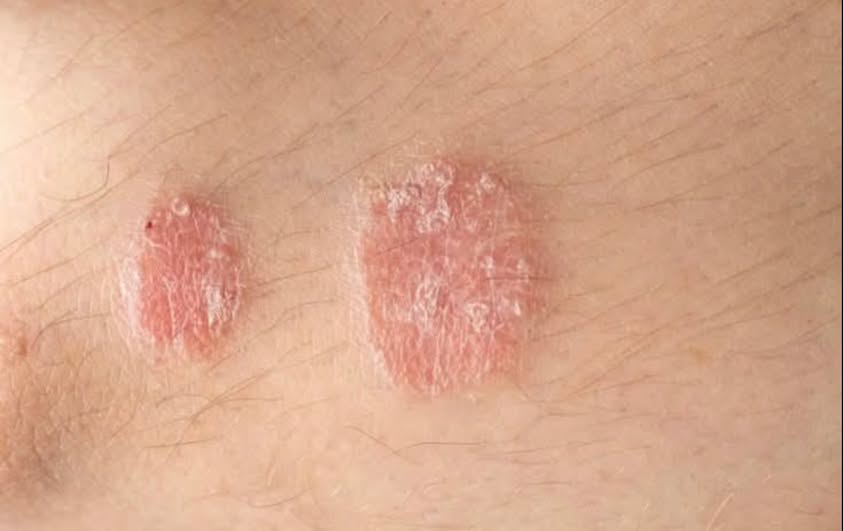Psoriasis is more than just a skin condition; it’s an autoimmune disorder that causes rapid skin cell turnover, leading to painful and often noticeable patches on the skin. If left untreated, it can impact your daily life, causing discomfort and emotional distress. Understanding the warning signs and symptoms of psoriasis is crucial for early detection and effective treatment.
Psoriasis is a chronic condition, affecting more than 125 million people worldwide, with 8 million of them in the United States alone. It’s essential to understand the different types of psoriasis and seek appropriate treatment before it worsens. Whether you’re dealing with itchy patches or inflamed skin, knowing when to seek medical help is vital for your health and well-being.
 Shutterstock.com
Shutterstock.com
Understanding Psoriasis
Psoriasis is an autoimmune disease where skin cells reproduce too quickly, resulting in a buildup of cells on the skin’s surface. This buildup forms scales, redness, and inflammation, often leading to discomfort and embarrassment due to the visible nature of the condition. While the exact cause remains unknown, genetics and environmental factors, such as infections and stress, play a significant role in triggering flare-ups.
There are five different types of psoriasis, each with its own set of symptoms. Let’s explore the warning signs you should never ignore.
Types of Psoriasis and Their Warning Signs
1. Plaque Psoriasis
Plaque psoriasis is the most common form of the condition, affecting most people with psoriasis. It is characterized by dry, itchy, raised patches of skin that are covered with scales. These patches are usually red or pink and often appear on the elbows, knees, lower back, and scalp. In some cases, the plaques may cause discoloration, especially in individuals with darker skin tones.
Key Signs of Plaque Psoriasis:
- Thick, scaly patches
- Red or pink with a silvery overlay
- Moderate to severe itching
If you notice any of these signs, it’s essential to consult a dermatologist for treatment options.
2. Guttate Psoriasis
Primarily affecting children and young adults, guttate psoriasis often develops after a bacterial infection, such as strep throat. This type manifests as small, teardrop-shaped spots on the skin, typically appearing on the trunk, arms, or legs. The spots are thinner and less scaly than those seen in plaque psoriasis.
Key Signs of Guttate Psoriasis:
- Small, teardrop-shaped spots
- Triggered by infections, such as strep throat
- Appears on the torso and limbs
If you experience these symptoms, it’s important to seek medical attention, especially if you’ve recently had a bacterial infection.
3. Inverse Psoriasis
Inverse psoriasis appears in skin folds, such as the groin, buttocks, and under the breasts. Unlike other forms of psoriasis, it doesn’t feature the usual scales but instead presents as smooth, shiny red patches. This type is often triggered by fungal infections and can worsen with sweating or friction.
Key Signs of Inverse Psoriasis:
- Smooth, shiny, red patches
- Appears in skin folds, such as the groin and underarms
- Worsens with friction and sweat
Because this form can be tricky to manage, it’s essential to keep the affected areas clean and dry.
4. Pustular Psoriasis
Pustular psoriasis is less common but can be more dramatic in appearance. It is characterized by white pustules (blisters filled with non-infectious pus) surrounded by red, inflamed skin. This form can occur on localized areas, such as the hands and feet, or spread across the body. Pustular psoriasis can also be accompanied by fever and chills, making it necessary to seek immediate medical help.
Key Signs of Pustular Psoriasis:
- Blisters filled with pus
- Red, inflamed skin surrounding the pustules
- Accompanied by fever or chills
If you notice pustules on your skin, it’s crucial to consult a healthcare professional right away.
5. Erythrodermic Psoriasis
The most severe and rare form of psoriasis, erythrodermic psoriasis causes widespread redness, scaling, and shedding of skin. It can cover large parts of the body and is often life-threatening. Severe itching, pain, and swelling are common symptoms. Erythrodermic psoriasis can be triggered by sunburn, infections, or stopping psoriasis treatment suddenly. If you experience this form, immediate medical attention is necessary.
Key Signs of Erythrodermic Psoriasis:
- Widespread redness and skin shedding
- Intense itching, pain, and swelling
- Triggers include sunburn, infections, and discontinuing treatment abruptly
This form requires immediate medical care and should never be ignored.
Psoriasis and Nail Changes
In addition to skin symptoms, psoriasis can affect your nails. Nail changes can be an early warning sign of psoriatic arthritis, a condition that causes inflammation in the joints. Psoriasis can cause nails to become thickened, pitted, discolored, or even detach from the nail bed (a condition known as onycholysis). If you notice these changes, it’s important to seek medical advice promptly.
Managing Psoriasis: Treatment Options
While there is no cure for psoriasis, there are various treatment options available to help manage symptoms and improve your quality of life. Depending on the severity of your condition, your dermatologist may recommend topical treatments, phototherapy, or systemic medications. It’s essential to work with your healthcare provider to develop a treatment plan tailored to your needs.
Common treatment options include:
- Topical treatments: Creams, ointments, and corticosteroids to reduce inflammation and itching.
- Phototherapy: Exposure to ultraviolet light to slow down skin cell turnover.
- Systemic medications: Oral or injectable medications that affect the entire immune system to control inflammation.
The Importance of Early Detection
Early detection of psoriasis is key to managing the condition effectively and preventing complications. If you notice any of the warning signs mentioned above, it’s important not to wait. Consult a dermatologist to receive an accurate diagnosis and create a treatment plan that suits your needs.
Conclusion
Psoriasis is a chronic autoimmune condition that can significantly impact your health and quality of life. Understanding the warning signs of the different types of psoriasis allows you to seek timely medical care and effectively manage the condition. Early treatment can help reduce symptoms, prevent flare-ups, and improve your overall well-being.
If you notice any unusual skin changes or suspect you may have psoriasis, don’t hesitate to seek professional advice from a dermatologist. Managing psoriasis early on is essential for your health and peace of mind.
For More Health-Related Insights, Check Out:
- Pope Francis’ Heartbreaking Final Gesture to His Nurse Before Death
- Pope Francis Describes Death as a New Beginning Before His Passing
- Man Eats Over 700 Eggs in One Month: A Surprising Experiment and Its Impact on the Body
- 20 Early Signs Your Body May Be Fighting Cancer: Understanding the Signals for Better Health
- 12 Health Benefits of Ginger: From Nausea Relief to Reducing Inflammation and More
- Potato Gel for Glowing Skin and Dark Spots
- What Happens to Your Body When You Drink Lemon Water with Turmeric Every Day?
- Why You Should Never Pour Hot Water into the Sink: A Costly Mistake
- Surprising Effects of Sleeping Without Clothes: Why You Should Try It


